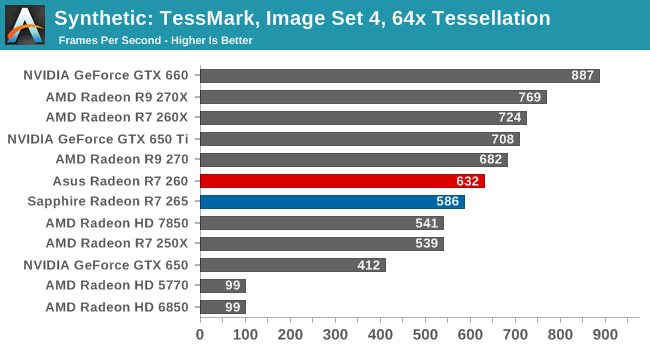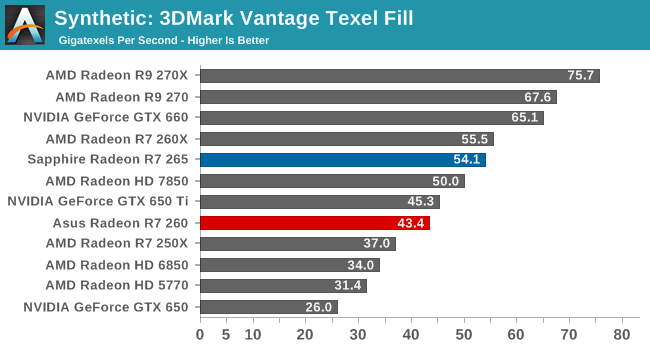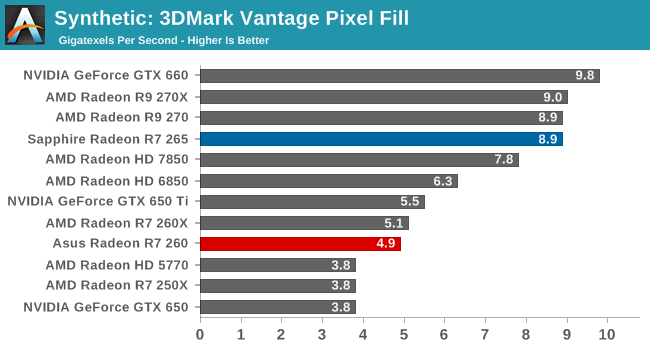The AMD Radeon R7 265 & R7 260 Review: Feat Sapphire & Asus
by Ryan Smith on February 13, 2014 8:00 AM ESTSynthetics
As always we’ll also take a quick look at synthetic performance. Since the R7 265 and R7 260 are based on the same venerable AMD GCN GPUs we've come to know over the last 1-2 years, there shouldn’t be any surprises here other than slight performance differences..

Right off the bat, TessMark highlights an interesting outcome of AMD’s clockspeed choices when paired with their geometry frontend design. Since both Pitcairn (R7 265) and Bonaire (R7 260) have the same 2 triangle/clock geometry rate, the higher clocked R7 260 actually offers better tessellation performance than the lower clocked R7 265. In gaming workloads of course there’s more than just geometry throughput to be concerned about, but this does bring to light one of those amusing edge cases where cards on either side of a GPU upgrade aren’t always faster than they first appear.


3DMark also finds an interesting edge case for us, once again relating to the number of processing units in R7 265. Texture throughput on R7 265 is slightly below R7 260X due to the fact that R7 260X’s 1.1GHz clockspeed more than makes up for the 12% deficit in the number of texture units available. The end result is that R7 260X is able to push more texels in a second than R7 265 can, even with fewer texture units to do it with.










52 Comments
View All Comments
Death666Angel - Thursday, February 13, 2014 - link
Who is surprised by that? No one that is following GPU reviews since multi-monitors became a thing for the consumer crowd. The first few generations had issues with monitors flickering in a multi-monitor setup because of too aggressive down clocking, so now they are being very conservative there and increase the clocks quite a bit.Solid State Brain - Thursday, February 13, 2014 - link
I don't think it's acceptable, though. AMD might have reduced idle consumption when a single monitor is being driven, but is still neglecting other usage scenarios that are becoming increasingly common. It's not even just a small power difference, especially with medium to high-end video cards.Da W - Thursday, February 13, 2014 - link
STFU.Anandtech had no problem calling 290 - 290X a terrible card because of its blower and the NOISE and crowning Nvidia once again. Much more now with AMD price hike.
The only biased guy here is YOU Nvidia fanboy.
silverblue - Thursday, February 13, 2014 - link
I don't think the price hikes are AMD's fault per se, however considering the inflated prices due to bitmining, you'd definitely want a better cooler than the stock one. The third party cards handle this nicely.Da W - Thursday, February 13, 2014 - link
My last post was directed to HisDivineOrder but the reply button doesn't seem to place my reply below his post.formulav8 - Thursday, February 13, 2014 - link
They always complain when something good is said about AMD whether the good is justified or not justified. They don't care either way.SolMiester - Thursday, February 13, 2014 - link
If this is just the 7xxx rebadge, then I guess it has the same multi GPU frame pacing issues....LOL, why dont they fix the damn thing FFS!...no CF Eyefinity, no DX9 pacing.....still shit!fiasse - Thursday, February 13, 2014 - link
Typo 'and R7 270 holding at $179 (MSRP)'Mr Perfect - Thursday, February 13, 2014 - link
With the naming of the card being so close to the 260X, I was really hoping this would be a faster GN1.1 part. How does AMD expect TrueAudio to catch on if they keep releasing card that don't support it? Hopefully the 300 series will sort this out and I can grab one to play Thief on.fiasse - Thursday, February 13, 2014 - link
looks like another typo on Asus R7 260 page, 'but this is an especially treacherous position if R7 260X prices quickly come down to $199.'